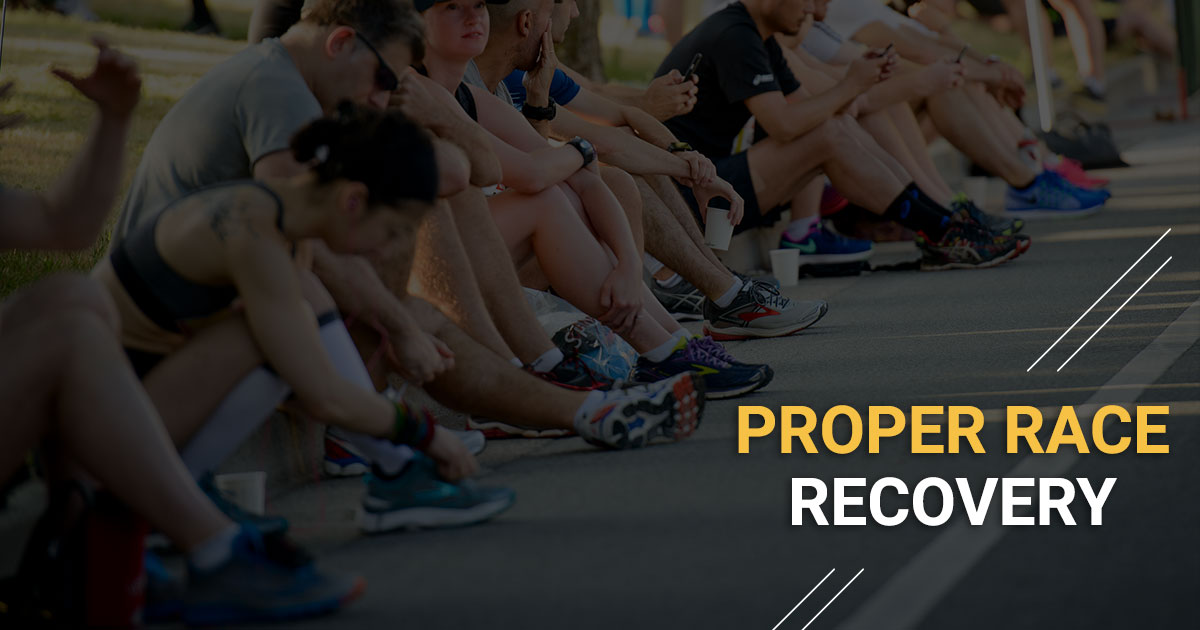
As soon as you step over the finish line, it’s important to think about recovering properly after a race. It’s usually overlooked, but is a crucial component of one’s training program. Accomplishing any race distance is certainly something that should be celebrated with post-race festivities, and a little rest and relaxation. But what happens after that? It’s easy to get through the pre-race taper, hit the ground running on race day, and bask in your success. But what’s the best way to get back into running? How long does recovery take? What’s the best way to recover?
Immediately after:
As soon as you cross the finish line don’t stop moving. Keep walking towards your medal, post-race food, and to see any friends and family that have come to support you. Working hard during a race causes your heart to pump blood and oxygen rapidly through your body, and will continue to do so even after you cross the line. By walking around for a good 15-20 minutes afterwards will help to avoid any blood from pooling in your extremities if you were to stop abruptly. Moving will help to flush out the metabolic waste that’s accumulated in your muscles from the race, and will aid in active recovery. Continue to move for the rets of the day too – nothing crazy, but after you’ve had a nap opt to go for a short walk in the evening to keep your muscles from tightening up.
Within one to two hours
Get some fluids and food in you as soon as you can. Burning through your energy stores, and sweating throughout a race can leave you depleted. Races will have some post-race food that will be great to bridge the gap between the end of the race and your next meal. Try to get a good amount of carbohydrates and protein to feed your exhausted muscles. It’s important to rehydrate with 16-20 oz of water for every pound of body weight you’ve lost during the race. Add in electrolytes, or grab a sports drink to replenish electrolytes lost through sweating. The amount you have to drink to rehydrate will depend on your sweat rate, the heat/humidity of the day, and how much you hydrated throughout the race. Keeping an eye on the colour of your urine is a good indicator: light yellow/lemonade is the colour to strive for. Try to avoid alcohol immediately after the race, or at least until you’ve had some water/electrolytes. Having depleted your body’s stores, the effects of the alcohol are much greater post-race and can impede your recovery.
24 hours after:
Getting a good night’s sleep after a big race is key. It can be difficult falling asleep after big efforts due to achy and restless legs. Avoid taking anti-inflammatories – your body elicits an inflammatory response as part of it’s healing process. The sore muscles may suck initially, but it’s all part of the process. If you’re having a tough time sleeping, look into taking melatonin. It is a natural substance created in our pineal gland that helps to regulate our sleep-wake cycle.
The day after a race, if your muscles are still sore and achy, take an ice bath. This will help speed up the recovery process by assisting the body in reducing the inflammation in the tissues. Use the day after a race to debrief about the race, go for a walk, and just relax. The down time after a race is just as important as the hard work before a race.
The week after the race:
Going back into training doesn’t need to be done right away. A lot of people will take a few days off, and go for walks/light cross training to keep their body moving and loose. The rule of thumb is in the first couple weeks after a race, follow the structure of the taper week, but in reverse. It’s a great guideline for easing back into intensity without overdoing it. Avoid too much intensity until about 10-14 days after the race to allow your muscles to fully recover before getting back into the swing of things. Also, don’t forget the importance of rolling and stretching. Many runners will book a massage or physio appointment for the week after a race to help flush their legs out. Both these options help your recovery by increasing blood flow to your recovering muscles.
Keep in mind that these guidelines are just suggestions. Everyone takes different times to heal and recover. Listen to your body to figure out the best approach for your return to training.







